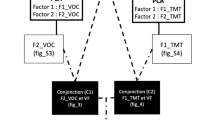Abstract
Electroencephalograms (EEGs) were recorded by 19 standard derivations in 57 subjects in a resting state with the eyes opened, during memorization of verbal bilingual semantic pairs (Latin and Russian), and during retrieval (monitoring) of the learned information. Statistical comparison of the EEG spectral power in the frequency bands θ, α1, α2, β1, β2, and γ showed that induction of the states of memorization (encoding) and retrieval of the verbal information led to multiple significant changes in the EEG absolute power (local synchronization) as compared to the state of rest. Such changes took place simultaneously in different frequency bands over the entire cortex. The relative values and significance of changes in different cortical regions varied. The main features of the EEG power-difference patterns were an increase in the power of the γ band over the entire cortex, a bilateral increase in the power of the β2 band in the temporal areas, and a decrease in the power of the α2 and α1 bands over a large part of the cortical surface. In the state of retrieval, synchronization in the γ- and β2 bands and desynchronization in the α2 band were significantly stronger than in the state of encoding. In the α1 band, desynchronization was more pronounced in the state of encoding than in the state of retrieval. The results are discussed in combination with the available data of the EEG studies of different types of memory.
Similar content being viewed by others
REFERENCES
Karpenko, M.P., The Problem of Measurement of Knowledge and Education Technologies, Zh. Prakt. Psikhol., 1997, no. 4, p. 107.
Izyumova, S.A. and Chmykhova, E.V., Realization of Ideas of Variable Individually Oriented Teaching in Education Technologies of the SGU, In Trudy SGU. Psikhologiya i sotsiologiya obrazovaniya (Proceedings of the SGU: Psychology and Sociology of Education), Moscow, 2001, p. 58.
Basar-Eroglu, C., Struber, D., Schurmann, M., et al., γ-Band Responses in the Brain: A Short Review of Psychophysiological Correlates and Functional Significance, Int. J. Psychophysiol., 1996, vol. 24, p. 101.
Klimesch, W., EEG α and θ Oscillations Reflect Cognitive and Memory Performance: A Review and Analysis, Brain Res. Rev., 1999, vol. 29, nos.2–3, p. 169.
Basar, E., Basar-Eroglu, C., Karakas, S., and Schurmann, M., Brain Oscillations in Perception and Memory, Int. J. Psychophysiol., 2000, vol. 35, p. 95.
McGaugh, J.L. and Gold, P.E., Modulation of Memory by Electrical Stimulation of the Brain, in Neural Mechanisms in Learning and Memory, Cambridge: Mass, 1976, p. 46.
Bekhtereva, N.P., Zdorovyi i bol'noi mozg cheloveka (Healthy and Diseased Human Brain), Leningrad: Nauka, 1988, 2nd ed.
Tikhomirova, I.V., Chmykhova, E.V., Shlyakhta, N.F., Standardization of the Technique for Measuring the Rate of Knowledge Acquisition (TUZ-V), in Trudy SGU. Gumanitarnye nauki. Psikhologiya i sotsiologiya obrazovaniya (Proceedings of the SGU: Human Sciences: Psychology and Sociology of Education), Moscow, 2002, issue 44, p. 30.
Kachalova, L.M., Bogolepova, S.F., and Plyplin, V.V., α-Rhythm and Rate of Knowledge Acquisition, in Trudy SGU. Gumanitarnye nauki. Psikhologiya i sotsiologiya obrazovaniya (Proceedings of the SGU: Human Sciences: Psychology and Sociology of Education), Moscow: SGU, 2002, issue 44, p. 180.
Fitzgibbon, S.P., Pope, K.J., Mackenzie, L., et al., Cognitive Tasks Augment γ EEG Power, Clin. Neurophysiol., 2004, vol. 115, no.8, p. 1802.
Tallon-Baudry, C., Bertrand, O., Peronnet, F., and Pernier, J., Induced γ-Band Activity during the Delay of a Visual Short-Term Memory Task in Humans, J. Neurosci., 1998, vol. 18, no.11, p. 4244.
Herrmann, C.S., Munk, M.H., and Engel, A.K., Cognitive Functions of γ-Band Activity: Memory Match and Utilization, Trends Cogn. Sci., 2004, vol. 8, no.8, p. 347.
Lutzenberger, W., Ripper, B., Busse, L., et al., Dynamics of γ-Band Activity during an Audiospatial Working Memory Task in Humans, J. Neurosci., 2002, vol. 22, no.13, p. 5630.
Kaiser, J. and Lutzenberger, W., Induced γ-Band Activity and Human Brain Function, Neuroscientist, 2003, vol. 9, no.6, p. 475.
Babiloni, C., Babiloni, F., Carducci, F., et al., Human Cortical EEG Rhythms during Long-Term Episodic Memory Task: A High-Resolution EEG Study of the HERA Model, Neuroimage, 2004, vol. 21, no.4, p. 1576.
Pulvermuller, F., Lutzenberger, W., Preissl, H., and Birbaumer, N., Spectral Responses in the γ-Band: Physiological Signs of Higher Cognitive Processes?, Neuroreport, 1995, vol. 6, no.15, p. 2059.
Sterman, M.B., Kaiser, D.A., and Veigel, B., Spectral Analysis of Event-Related EEG Responses during Short-Memory Performance, Brain Topogr., 1996, vol. 9, p. 21.
Gevins, A., Smith, M.E., McEvoy, L., and Yu, D., High-Resolution EEG Mapping of Cortical Activation Related to Working Memory: Effects of Task Difficulty, Type of Processing, and Practice, Cereb. Cortex, 1997, vol. 7, no.4, p. 374.
Klimesch, W., EEG α Rhythms and Memory Processes, Int. J. Psychophysiol., 1997, vol. 26, nos.1–3, p. 319.
Klimesch, W., Doppelmayer, M., Schwaiger, J., et al., “Paradoxical” α Synchronization in a Memory Task, Brain Res. Cogn. Brain Res., 1999, vol. 7, no.4, p. 493.
Klimesch, W., Doppelmayer, M., Rohm, D., et al., Simultaneous Desynchronization and Synchronization of Different α Responses in the Human Electroencephalogram: A Neglected Paradox?, Neurosci. Lett., 2000, vol. 284, nos.1–2, p. 97.
Krause, C.M., Sillanmaki, L., Koivisto, M., et al., The Effects of Memory Load on Event-Related EEG Desynchronization and Synchronization, Clin. Neurophysiol, 2000, vol. 111, no.11, p. 2071.
Jensen, O., Gelfand, J., Kounious, J., and Lisman, J.E., Oscillations in the α Band (9–12 Hz) Increase with Memory Load during Retention in a Short-Term Memory Task, Cereb. Cortex, 2002, vol. 12, no.8, p. 877.
Schack, B. and Klimesch, W., Frequency Characteristics of Evoked and Oscillatory Electroencephalic Activity in a Human Memory Scanning Task, Neurosci. Lett., 2002, vol. 331, no.2, p. 107.
Sauseng, P., Klimesch, W., Gruber, W., et al., The Interplay between θ and α Oscillations in the Human Electroencephalogram Reflect the Transfer of Information between Memory Systems, Neurosci. Lett., 2002, vol. 324, no.2, p. 121.
Duzel, E., Habib, R., Schott, B., et al., A Multivariate, Spatiotemporal Analysis of Electromagnetic Time-Frequency Data of Recognition Memory, Neuroimage, 2003, vol. 18, no.2, p. 185.
Herrmann, C.S., Senkowski, D., and Rottger, S., Phase-Locking and Amplitude Modulations of EEG α: Two Measures Reflect Different Cognitive Processes in a Working Memory Task, Exp. Psychol., 2004, vol. 51, no.4, p. 311.
Author information
Authors and Affiliations
Additional information
__________
Translated from Fiziologiya Cheloveka, Vol. 31, No. 5, 2005, pp. 13–20.
Original Russian Text Copyright © 2005 by Danko, Bechtereva, Kachalova, Shemyakina, Startchenko.
Rights and permissions
About this article
Cite this article
Danko, S.G., Bechtereva, N.P., Kachalova, L.M. et al. Electroencephalographic Correlates of Brain States during Verbal Learning: I. Characteristics of EEG Local Synchronization. Hum Physiol 31, 504–510 (2005). https://doi.org/10.1007/s10747-005-0089-x
Received:
Issue Date:
DOI: https://doi.org/10.1007/s10747-005-0089-x




